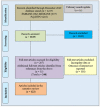Recognition and Management of Antipsychotic-Induced Parkinsonism in Older Adults: A Narrative Review
- PMID: 34073269
- PMCID: PMC8227528
- DOI: 10.3390/medicines8060024
Recognition and Management of Antipsychotic-Induced Parkinsonism in Older Adults: A Narrative Review
Abstract
Background: Parkinsonism is a common side-effect of antipsychotic drugs especially in older adults, who also present with a higher frequency of neurodegenerative disorders like Idiopathic Parkinson's disease (IPD). Distinguishing between antipsychotic-induced parkinsonism (AIP) and IPD is challenging due to clinical similarities. Up to 20% of older adults may suffer from persisting parkinsonism months after discontinuation of antipsychotics, suggesting underlying neurodegeneration. A review of the literature on AIP in older adults is presented, focusing on epidemiology, clinical aspects, and management.
Methods: A literature search was undertaken on EMBASE, MEDLINE and PsycINFO, for articles on parkinsonism induced by antipsychotic drugs or other dopamine 2 receptor antagonists in subjects aged 65 or older.
Results: AIP in older adults is the second most common cause of parkinsonism after IPD. Older age, female gender, exposure to high-potency first generation antipsychotics, and antipsychotic dosage are the main risk factors. The clinical presentation of AIP resembles that of IPD, but is more symmetrical, affects upper limbs more, and tends to have associated motor phenomena such as orofacial dyskinesias and akathisia. Presence of olfactory dysfunction in AIP suggests neurodegeneration. Imaging of striatal dopamine transporters is widely used in IPD diagnosis and could help to distinguish it from AIP. There is little evidence base for recommending pharmacological interventions for AIP, the best options being dose-reduction/withdrawal, or switching to a second-generation drug.
Conclusions: AIP is a common occurrence in older adults and it is possible to differentiate it from IPD. Further research is needed into its pathophysiology and on its treatment.
Keywords: antipsychotic drugs; older adults; parkinsonism.
Conflict of interest statement
The authors report no conflict of interest.
Figures
Similar articles
-
Drug-induced parkinsonism in the elderly: incidence, management and prevention.Drugs Aging. 2012 Feb 1;29(2):105-18. doi: 10.2165/11598540-000000000-00000. Drugs Aging. 2012. PMID: 22250585 Review.
-
Pharmacogenetics of antipsychotic-induced movement disorders as a resource for better understanding Parkinson's disease modifier genes.Front Neurol. 2015 Feb 20;6:27. doi: 10.3389/fneur.2015.00027. eCollection 2015. Front Neurol. 2015. PMID: 25750634 Free PMC article. Review.
-
Call to Caution with the Use of Atypical Antipsychotics for Treatment of Depression in Older Adults.Geriatrics (Basel). 2016 Dec 16;1(4):33. doi: 10.3390/geriatrics1040033. Geriatrics (Basel). 2016. PMID: 31022826 Free PMC article.
-
Diagnosing non-parkinson's movement disorders.Practitioner. 2012 Feb;256(1748):21-4, 3. Practitioner. 2012. PMID: 22497105
-
Using antipsychotic agents in older patients.J Clin Psychiatry. 2004;65 Suppl 2:5-99; discussion 100-102; quiz 103-4. J Clin Psychiatry. 2004. PMID: 14994733 Review.
Cited by
-
Phenytoin-associated movement disorder: A literature review.Tzu Chi Med J. 2022 Oct 3;34(4):409-417. doi: 10.4103/tcmj.tcmj_74_22. eCollection 2022 Oct-Dec. Tzu Chi Med J. 2022. PMID: 36578637 Free PMC article. Review.
-
Drug-Induced Parkinsonism or Parkinson's Disease: A Diagnostic Challenge in a Psychiatric Patient.Cureus. 2025 Jul 17;17(7):e88177. doi: 10.7759/cureus.88177. eCollection 2025 Jul. Cureus. 2025. PMID: 40678744 Free PMC article.
-
The Advances in Antipsychotics-Induced Dyskinesia Rodent Models: Benefits of Antioxidant Supplementation.Biomedicines. 2025 Feb 18;13(2):512. doi: 10.3390/biomedicines13020512. Biomedicines. 2025. PMID: 40002925 Free PMC article. Review.
-
Prevention of Parkinson's Disease: From Risk Factors to Early Interventions.CNS Neurol Disord Drug Targets. 2024;23(6):746-760. doi: 10.2174/1871527322666230616092054. CNS Neurol Disord Drug Targets. 2024. PMID: 37326115 Review.
-
Treatment Changes and Prognoses in Patients with Incident Drug-Induced Parkinsonism Using a Korean Nationwide Healthcare Claims Database.J Clin Med. 2023 Apr 13;12(8):2860. doi: 10.3390/jcm12082860. J Clin Med. 2023. PMID: 37109197 Free PMC article.
References
-
- Chou K.L., Friedman J.H. Drug-induced parkinsonism in the elderly. Future Neurol. 2007;2:307–316. doi: 10.2217/14796708.2.3.307. - DOI
Publication types
LinkOut - more resources
Full Text Sources
Miscellaneous


